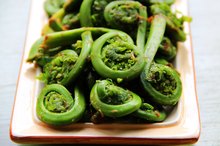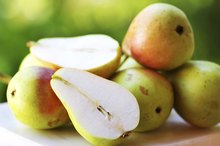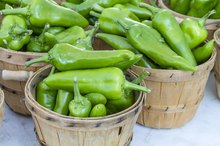What does fact checked mean?
At Healthfully, we strive to deliver objective content that is accurate and up-to-date. Our team periodically reviews articles in order to ensure content quality. The sources cited below consist of evidence from peer-reviewed journals, prominent medical organizations, academic associations, and government data.
- Linus Pauling Institute: Vitamin A
- MedlinePlus: Antioxidants
- MedlinePlus: B Vitamins
- MedlinePlus: Iron in Diet
The information contained on this site is for informational purposes only, and should not be used as a substitute for the advice of a professional health care provider. Please check with the appropriate physician regarding health questions and concerns. Although we strive to deliver accurate and up-to-date information, no guarantee to that effect is made.
Hog Plum Health Benefits
Hog plum is the generic name for all fruits from the hog plum tree, which belongs to the Spondias genus. Hog plums are native to Latin America and widely eaten in Southeast Asia. They are also called mombins, gully plums or Spanish plums and are often yellow or purple. Wild American plums (Prunus americana) are also colloquially called hog plums, although they are not true hog plums.
Nutritional Information
Yellow hog plums have around 35 calories per 100-gram serving, while purple hog plums have varying caloric content because the ripeness of the fruit changes it so much. While both colors of hog plum contain dietary fiber, yellow hog plums are a better source of dietary fiber than purple ones as they have 1.17 grams per 100-gram serving, compared to 0.5 gram for purple hog plums. Both purple and yellow hog plums contain minimal amounts of protein and fat, although yellow hog plums have more of both nutrients.
Rich in Natural Antioxidants
Nutritional Value in Li Hing Mui
Learn More
Hog plums contain vitamins A and C. Yellow plums have 71 international units per 100-gram serving of the first and 46 milligrams of the second. Purple plums contain between 26 and 73 milligrams of vitamin C per serving, and only trace amounts of vitamin A. Both vitamins are natural antioxidants, protecting your body from damage from free radicals 5. Vitamin C is needed to maintain skin, ligaments, hair and tendons, while also providing support for your body’s immune system. Vitamin A is needed for eye health and also provides support to your immune system.
- Hog plums contain vitamins A and C. Yellow plums have 71 international units per 100-gram serving of the first and 46 milligrams of the second.
- Purple plums contain between 26 and 73 milligrams of vitamin C per serving, and only trace amounts of vitamin A.
- Both vitamins are natural antioxidants, protecting your body from damage from free radicals 5.
Other Vitamins and Minerals
Both yellow and purple hog plums contain small amounts of vitamin B, which helps your body use and make energy. Yellow hog plums have 2.8 milligrams of iron per serving, and purple hog plums have an average of 0.66 milligram per serving. This means yellow hog plums provide 15.5 to 35 percent of the recommended intake of iron, while purple hog plums provide 3.7 to 8.3 percent per serving.
What to Do With Hog Plums
Nutritional Benefits of Black Currant Juice
Learn More
Both purple and yellow hog plums are commonly eaten raw as a snack. In Latin America, the fruits are eaten primarily for hydration purposes. Purple and yellow hog plums are also pickled with chili peppers to make a spicy condiment, and they can be processed into a juice and made into jams. Purple hog plums are commonly stewed in sugar and served whole and pitted as a dessert.
- Both purple and yellow hog plums are commonly eaten raw as a snack.
- Purple hog plums are commonly stewed in sugar and served whole and pitted as a dessert.
Related Articles
References
- Purdue University: Yellow Mombin
- Purdue University: Purple Mombin
- University of Maryland Medical Center: Vitamin C (Ascorbic Acid)
- Linus Pauling Institute: Vitamin A
- MedlinePlus: Antioxidants
- MedlinePlus: B Vitamins
- MedlinePlus: Iron in Diet
- U.S. Department of Agriculture: Plants -- Wild Plum, Prunus Americana Marsh
- Lever E, Cole J, Scott SM, Emery PW, Whelan K. Systematic review: the effect of prunes on gastrointestinal function. Aliment Pharmacol Ther. 2014;40(7):750-758. doi:10.1111/apt.12913
- Plum, raw. FoodData Central. U.S. Department of Agriculture. Published April 1, 2019
- Carr AC, Maggini S. Vitamin C and immune function. Nutrients. 2017;9(11):1211. doi:10.3390/nu9111211
- Igwe EO, Charlton KE. A systematic review on the health effects of plums (Prunus domestica and Prunus salicina). Phytother Res. 2016;30(5):701-731. doi:10.1002/ptr.5581
- Huang D. Dietary antioxidants and health promotion. Antioxidants (Basel). 2018;7(1):9. doi:10.3390/antiox7010009
- Ahmed T, Sadia H, Batool S, Janjua A, Shuja F. Use of prunes as a control of hypertension. J Ayub Med Coll Abbottabad. 2010;22(1):28–31
- Muraki I, Imamura F, Manson JE, et al. Fruit consumption and risk of type 2 diabetes: results from three prospective longitudinal cohort studies. BMJ. 2013;347:f5001. doi:10.1136/bmj.f5001
- Oral allergy syndrome (OAS) or pollen fruit syndrome (PFS). American Academy of Allergy, Asthma & Immunology.
- Cozma-Petruţ A, Loghin F, Miere D, Dumitraşcu DL. Diet in irritable bowel syndrome: What to recommend, not what to forbid to patients!. World J Gastroenterol. 2017;23(21):3771-3783. doi:10.3748/wjg.v23.i21.3771
- Becalski A, Brady B, Feng S, Gauthier BR, Zhao T. Formation of acrylamide at temperatures lower than 100°C: the case of prunes and a model study. Food Addit Contam Part A Chem Anal Control Expo Risk Assess. 2011;28(6):726–730. doi:10.1080/19440049.2010.535217
- Kumar J, Das S, Teoh SL. Dietary acrylamide and the risks of developing cancer: Facts to ponder. Front Nutr. 2018;5:14. doi:10.3389/fnut.2018.00014
- Acrylamide. National Institute of Environmental Health Sciences. Updated: January 17, 2020
- Allergy information for: Garden plum (Prunus domestica). University of Manchester. Updated October 18, 2006.
Writer Bio
Marie Dannie has been a professional journalist since 1991, specializing in nutrition and health topics. She has written for "Woman’s Own," the "Daily Mail," the "Daily Mirror" and the "Telegraph." She is a registered nutritionist and holds a Bachelor of Science degree with honors in food science from the University of Nottingham.









